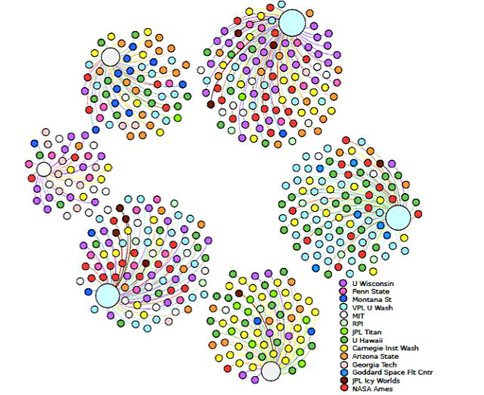2012 Annual Science Report
 University of Hawaii, Manoa
Reporting | SEP 2011 – AUG 2012
University of Hawaii, Manoa
Reporting | SEP 2011 – AUG 2012
Measuring Interdisciplinarity Within Astrobiology Research
Project Summary
To integrate the work of the diverse scientists working on astrobiology, we have harvested and analyzed thousands of astrobiology documents to reveal areas of potential connection. This framework allows us to identify crossover documents that guide scientists quickly across vast interdisciplinary libraries, suggest productive interdisciplinary collaborations, and provide a metric of interdisciplinary science.
Project Progress
AIRFrame analyzes published and unpublished documents to identify and visualize implicit relationships between astrobiology’s diverse constituent fields. The main goals of AIRFrame are to allow researchers and the public to discover related information from different disciplines, and to provide a metric of interdisciplinary science.
During the reporting period, AIRFrame has evolved from a conceptual system to a modular suite of tools, methods and technologies designed to represent researcher output accurately, integrate documents from diverse sources, and triangulate best practices. We modeled the output of astrobiology researchers primarily in two ways: by analyzing the full text of annual reports and publications from each NAI team, and by representing the publications of a single team (UHNAI) by both the abstracts of published articles, and the abstracts of the papers they cite. Our initial results suggest that a balance of both approaches can be used to identify crossover documents, potential collaborations between researchers, and to provide a metric of interdisciplinarity at the level of an NAI team, a scientist and an individual paper. Refining these results will allow us to evaluate the extent to which NAI goals and sub-goals from the Astrobiology Roadmap are being addressed by NAI research output. We have also investigated the public perception of astrobiology in social media, to inform public outreach and to create new connections between astrobiology and computer science.
The relative contribution of teams within and across clusters is visualized here. Teams contributing across multiple clusters may indicate more interdisciplinarity.
This plot provides a measure of the diversity of each scientist’s publications, and areas of potential overlap with researchers in other fields. Future work will extend the analysis to other NAI teams.
Publications
-
Gowanlock, M., & Gazan, R. (2012). Assessing researcher interdisciplinarity: a case study of the University of Hawaii NASA Astrobiology Institute. Scientometrics, 94(1), 133–161. doi:10.1007/s11192-012-0765-y
-
PROJECT INVESTIGATORS:
-
PROJECT MEMBERS:
Rich Gazan
Project Investigator
Mike Gowanlock
Graduate Student
Lisa Miller
Graduate Student
-
RELATED OBJECTIVES:
Objective 1.1
Formation and evolution of habitable planets.
Objective 1.2
Indirect and direct astronomical observations of extrasolar habitable planets.
Objective 2.1
Mars exploration.
Objective 2.2
Outer Solar System exploration
Objective 3.1
Sources of prebiotic materials and catalysts
Objective 3.2
Origins and evolution of functional biomolecules
Objective 3.3
Origins of energy transduction
Objective 3.4
Origins of cellularity and protobiological systems
Objective 4.1
Earth's early biosphere.
Objective 4.2
Production of complex life.
Objective 4.3
Effects of extraterrestrial events upon the biosphere
Objective 5.1
Environment-dependent, molecular evolution in microorganisms
Objective 5.2
Co-evolution of microbial communities
Objective 5.3
Biochemical adaptation to extreme environments
Objective 6.1
Effects of environmental changes on microbial ecosystems
Objective 6.2
Adaptation and evolution of life beyond Earth
Objective 7.1
Biosignatures to be sought in Solar System materials
Objective 7.2
Biosignatures to be sought in nearby planetary systems

